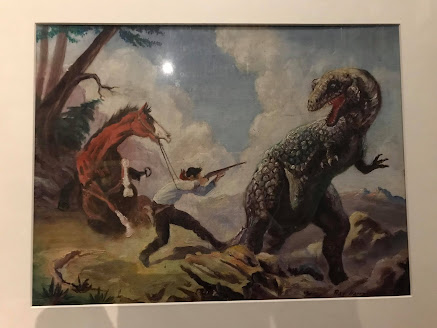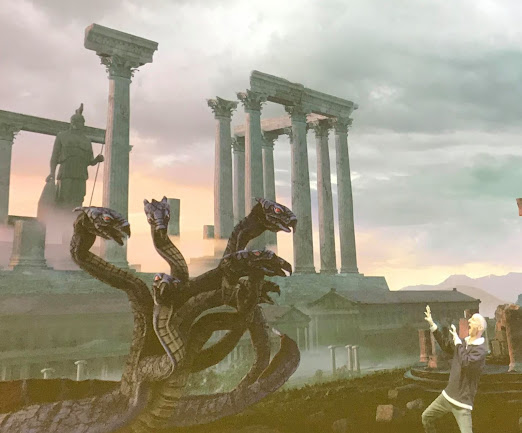Hi reader
Yesterday I went to the Scottish National Gallery of Modern Art to see the Ray Harryhausen exhibition. This was a huge treat for this movie fan who grew up in the age before CGI when some of cinema's most terrifying monsters were created using stop motion animation.
Ray Harryhausen's influence on today's filmmakers was enormous, with luminaries; Steven Spielberg, James Cameron, Peter Jackson, George Lucas, John Landis and the U.K.'s own Nick Park having cited Harryhausen as being the man whose work inspired their own creations. He was a titan of cinema!

Social distancing is still very much in place in Scotland, so attendance numbers were limited. This was in my favour as it gave me plenty of opportunities to get close to the various models Ray Harryhausen used to bring his ideas to life, as well as lots of other fascinating artifacts from his life and career.
The exhibition begins with a room dedicated to King Kong (1933), the film which inspired Harryhausen to begin experimenting in the production of animated shorts.

The scenes utilising stop-motion animation featuring creatures on the island or Kong, were the work of pioneer model animator Willis O'Brien. His work in King Kong enthralled Harryhausen, and a friend arranged a meeting with O'Brien for him. O'Brien critiqued Harryhausen's early models and urged him to take classes in graphic arts and sculpture to hone his skills.
While still at high school, Ray Harryhausen made marionettes so that he could recreate some of his favourite scenes from King Kong and other films of the time.


And here are some of his tools for creating concept art and models.
From a young age, Ray Harryhausen was fascinated by prehistoric monsters. It was a passion he shared with his lifelong friend, the writer Ray Bradbury. This is an early model of a triceratops Harryhausen made using a metal skeleton and latex rubber covering.
Willis O'Brien had instilled in Harryhausen the importance of planning his models using drawings. Something I learned at this exhibition is that Ray Harryhausen was also a talented artist. He did this picture showing a cowboy fighting a dinosaur when he was just nineteen years old.
And many years later, this concept of cowboys VS dinosaurs would come to life when he worked on The Valley of Gwangi. It was made the year I was born, and I saw it on TV when I was quite young. I thought it was amazing; there were always cowboy films and shows on TV in the 1970s but this was the first time I'd seen a cowboy film that had dinosaurs in it.
Early in the film, we see a rodeo show that has a very special star attraction: a tiny horse called El Diablo. It is, in fact, a prehistoric Eohippus, captured in a place known as the forbidden valley. Here is Ray Harryhausen's concept sketch for the Eohippus:
And imagine my surprise and joy when I looked around the next corner and there it was - El Diablo!
This is the actual model used in the film. I haven't seen it since it was on my tv screen in the 1970s.
And here's the title character himself, Gwangi, A vicious Allosaurus who rules the forbidden valley.
The Valley of Gwangi is a parallel Kong story. The cowboys eventually capture Gwangi and bring him to the nearest Mexican town for exhibition. You can guess how this story plays out.
Another thing I learned at the exhibition is that Ray Harryhausen worked alone in creating the majority of his animations. It was only in his final movie, Clash of the Titans (1981) that he had animation assistants. Here, cast in bronze, are the hands that made all those creatures come to life.
This is Harryhausen's typewriter, which he used to write the scripts for his action sequences. There's a Clash of the Titans headed paper in the reel.
One of Ray Harryhausen's most celebrated and memorable films is Jason and the Argonauts (1963). Although it was a box office disappointment during its initial release, the film was critically acclaimed and later became a cult classic.
When Jason and his crew of Argonauts travel to the Island of Bronze, they meet the giant bronze statue of Talos. The statue comes to life and attacks the Argonauts.
And I had my own terrifying encounter with Talos ...
... through the magic of the exhibition's green screen room!
Later, Jason and his men land on the island of Colchis, where they hope to find the Golden Fleece. Unfortunately, the treasure is guarded by the deadly seven-headed Hydra. Here's some more of Harryhausen's amazing concept art.
Aieeee! It's here! The Hydra!
Ho ho. Don't worry, reader. Just more green screen trickery.


Even with the Hydra defeated, Jason's trials aren't over. King Aeëtes sows the Hydra's teeth and prays to the goddess Hecate. Seven sword-wielding skeletons, the 'children of the Hydra's teeth', emerge from the ground. This is surely one of the most iconic climactic battles in cinema history.
The model skeletons are much smaller than I expected. They're only about 6 inches tall, yet they look so amazing in the film as they battle Jason and friends.
"Destroy them! Kill them all! Kill, kill, kill them all!"
Describing the scene, Harryhausen said "I had three men fighting seven skeletons, and each skeleton had five appendages to move in each separate frame of film. This meant at least thirty-five animation movements, each synchronized to the actor's movements. Some days I was producing just 13 or 14 frames a day, or to put it another way, less than one second of screen time per day, and in the end the whole sequence took a record four and a half months to capture on film."
Harryhausen's career also brought us three Sinbad films. Growing up, I thought there were many more, but I now realize I must have just been seeing the same three films over and over again.
A memorable scene from The Golden Voyage of Sinbad (1973) saw our hero fight the six-armed living statue of Kali, brandishing a sword in each hand. Here's the model of Kali.
In Sinbad and the Eye of the Tiger (1977), I was always frightened of the Minoton, a magical bronze automaton with the appearance of a minotaur. However it was all build up and no delivery. Throughout the film we saw the Minoton rowing a boat across the ocean, with menacing music playing. How on Earth would Sinbad possibly defeat this terrifying foe? The answer is, he didn't. As I recall, he never even met it. There was a scene where an evil sorceress ordered the Minoton to remove a giant block of stone from the side of a pyramid. The Minoton obeyed, lost its balance and toppled backwards to be crushed by the stone block. And that was it! What an anticlimax. Even as a kid I thought - what was the point of the Minoton even being in the film? I still thought it was a cool monster, but it seemed stupid to build it up throughout the story only to have it crushed by a big stone.

And so to Ray Harryhausen's final feature film, Clash of the Titans (1981). By this point, Harryhausen had honed his stop motion techniques to perfection, and this film contains an amazing array of fantastical creatures and monsters.
All of the models from Clash of the Titans were included in the exhibition.
Here's one of the 'giant' scorpions.
And this is the wicked, Calibos. I found him terrifying!
This sequence of pictures shows the detailed planning that went into bringing the mythical, winged horse, Pegasus, to life for the movie.
This is one of Harryhausen's concept sketches for the gargantuan Kraken.
A fan favourite from the movie was the mechanical owl, Bubo. Despite its similarities to Star Wars' R2D2, Harryhausen insisted he conceived and designed Bubo before Star Wars was released.
And for me, the most frightening adversary in Clash of the Titans was ... the Medusa! Be careful. Don't make direct eye contact.
Clash of the Titans was released in June of 1981 and made its budget back within weeks. Though it’s not considered to be Harryhausen’s best movie (most people prefer Jason and the Argonauts) it’s one of his most successful. It was one of the highest-grossing films of the year, and a re-release the following year only added to the popularity.
In 1991, Ray Harryhausen won the Gordon Sawyer award for technological contributions to the motion picture industry, and he received his Oscar trophy from the actor, Tom Hanks.
And in 2010 he also received a BAFTA for his 'unique and outstanding contribution to cinema'.
I had such a great afternoon reliving my childhood at this exhibition and I recommend it to any fan of the silver screen. The exhibition has been extended until Sunday the 20th of February 2022, so if you're visiting Edinburgh, be sure to check it out.
Thanks for reading,
Brian












































No comments:
Post a Comment